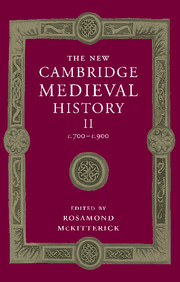Book contents
- Frontmatter
- PART I POLITICAL DEVELOPMENT
- 1 Introduction: sources and interpretation
- 2 The British Isles
- 3 Frankish Gaul to 814
- 4 The Frankish kingdoms, 814–898: the West
- 5 The Frankish Kingdoms, 817–911: the East and Middle Kingdoms
- 6 Fines Imperii: the Marches
- 7 The Vikings in Francia and Anglo-Saxon England to 911
- 8 Scandinavia, c. 700–1066
- 9 Slavs and Bulgars
- 10 The Muslims in Europe
- 11 Spain: the northern kingdoms and the Basques, 711–910
- 12 Lombard and Carolingian Italy
- 13 Byzantine Italy, c. 680–c. 876
- 14 Byzantium and the west, 700–900
- PART II GOVERNMENT AND INSTITUTIONS
- PART III CHURCH AND SOCIETY
- PART IV CULTURE AND INTELLECTUAL DEVELOPMENTS
- Conclusion
- Appendix genealogical tables
- List of primary sources
- Bibliography of secondary works arranged by chapter
- Index of manuscripts
- General index
- Frontispiece">
- Plate section
- Map 4 Charlemagne’s Europe and Byzantium, 814
- Map 19 The ecclesiastical provinces of western Europe 700-900
- Map 20 Carolingian schools, scriptoria and literary centres
- Genealogical table X: Wessex
- References
13 - Byzantine Italy, c. 680–c. 876
from PART I - POLITICAL DEVELOPMENT
Published online by Cambridge University Press: 28 March 2008
- Frontmatter
- PART I POLITICAL DEVELOPMENT
- 1 Introduction: sources and interpretation
- 2 The British Isles
- 3 Frankish Gaul to 814
- 4 The Frankish kingdoms, 814–898: the West
- 5 The Frankish Kingdoms, 817–911: the East and Middle Kingdoms
- 6 Fines Imperii: the Marches
- 7 The Vikings in Francia and Anglo-Saxon England to 911
- 8 Scandinavia, c. 700–1066
- 9 Slavs and Bulgars
- 10 The Muslims in Europe
- 11 Spain: the northern kingdoms and the Basques, 711–910
- 12 Lombard and Carolingian Italy
- 13 Byzantine Italy, c. 680–c. 876
- 14 Byzantium and the west, 700–900
- PART II GOVERNMENT AND INSTITUTIONS
- PART III CHURCH AND SOCIETY
- PART IV CULTURE AND INTELLECTUAL DEVELOPMENTS
- Conclusion
- Appendix genealogical tables
- List of primary sources
- Bibliography of secondary works arranged by chapter
- Index of manuscripts
- General index
- Frontispiece">
- Plate section
- Map 4 Charlemagne’s Europe and Byzantium, 814
- Map 19 The ecclesiastical provinces of western Europe 700-900
- Map 20 Carolingian schools, scriptoria and literary centres
- Genealogical table X: Wessex
- References
Summary
bryzantine italy in 680
By the last quarter of the seventh century the Byzantine areas of Italy had experienced over a century of upheaval. Within decades of their first invasion of Italy in 568 the Lombards had established a powerful kingdom consisting of the territories north of the river Po, Tuscany and the two outlying duchies of Spoleto and Benevento. The empire was confined to the areas of Rome and its duchy, Ravenna and the neighbouring areas of the Exarchate and Pentapolis, approximating to the present-day Romagna and Marche, and a few coastal areas elsewhere. The Byzantines had only been able to hold on to their possessions by initiating a thorough-going militarisation of society, which involved the concentration of land in military hands and the concentration of authority in the hands of the commander-in-chief in Ravenna (the exarch) and his subordinates (duces and magistri militum at a provincial level and tribuni in the localities). In many areas, such as the Roman Campagna, this process was accompanied by a steady shift of population, as settlement became concentrated on military strongholds and refuges, usually located on promontory sites. Although the pressure eased somewhat in the seventh century, Liguria and most of the remaining settlements on the Venetian mainland were lost to the Lombards in the reign of King Rothari (636–52), and the duchy of Benevento made continual encroachments in the south, which accelerated after the unsuccessful expedition of Constans II to southern Italy (663–8).
- Type
- Chapter
- Information
- The New Cambridge Medieval History , pp. 320 - 348Publisher: Cambridge University PressPrint publication year: 1995
References
- 4
- Cited by

